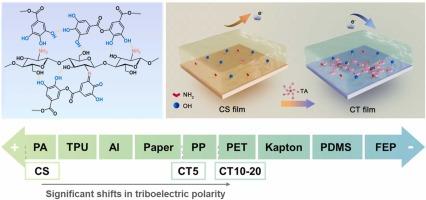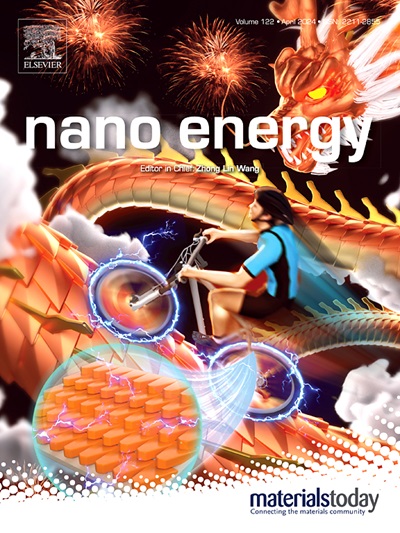通过单宁酸表面改性有效改变壳聚糖薄膜的三电荷行为
IF 16.8
1区 材料科学
Q1 CHEMISTRY, PHYSICAL
引用次数: 0
摘要
三电荷行为的变化会极大地影响三电纳米发电机的性能,包括三电极性的变化。然而,有关生物聚合物这些特性的研究仍然有限,这就造成了对三电性理解的知识空白,并限制了材料的选择。本研究提出了一种新策略,通过单宁酸(TA)表面改性来改变壳聚糖薄膜的三电荷行为。TA 的没食子酰基与作为电子负载位点的 -NH2 基团相互作用,没食子酰基内的芳香结构进一步改变了表面特性,使三电极性从正向转变为相对负向。TA 浓度为 10% 的改性壳聚糖薄膜的电荷密度达到 182 μC m-2,并表现出优异的机械性能,包括 55.8 兆帕的拉伸强度。它还具有更强的防潮性能,水溶性仅为 12.8%,在 256 μg mL-1 的条件下对金黄色葡萄球菌的抑制率为 96.5%。这些特点使其成为生物医学应用的绝佳候选材料。此外,还进一步开发了电荷操纵的潜在应用,以提高羽绒的蓬松度。这项研究为改变壳聚糖的三电荷行为和扩大其伙伴材料的选择范围提供了一种很有前景的方法。本文章由计算机程序翻译,如有差异,请以英文原文为准。

Effectively altering the triboelectric charging behavior of chitosan films via tannic acid surface modification
Variations in triboelectric charging behavior significantly influence the performance of triboelectric nanogenerators, including shifts in triboelectric polarity. However, research on biopolymers with respect to these characteristics remains limited, creating a knowledge gap in the understanding of triboelectricity and restricting material options. In this study, a novel strategy is proposed for altering the triboelectric charging behavior of chitosan films through tannic acid (TA) surface modification. The galloyl groups of TA interact with the -NH2 groups that serve as electron-donating sites, and the aromatic structure within galloyl groups further modifies the surface properties, shifting triboelectric polarity from positive towards relatively negative. The modified chitosan film with 10 % TA concentration reached a charge density of 182 μC m−2 and demonstrated exceptional mechanical properties, including a tensile strength of 55.8 MPa. It also exhibited enhanced moisture resistance with a water solubility of just 12.8 %, and showed 96.5 % inhibition efficiency against S. aureus at 256 μg mL−1. These features make it an excellent candidate for biomedical applications. Additionally, a potential application of charge manipulation to enhance the fluffiness of down was further developed. This work presents a promising approach to modify the triboelectric charging behavior of chitosan and broaden its partner material options.
求助全文
通过发布文献求助,成功后即可免费获取论文全文。
去求助
来源期刊

Nano Energy
CHEMISTRY, PHYSICAL-NANOSCIENCE & NANOTECHNOLOGY
CiteScore
30.30
自引率
7.40%
发文量
1207
审稿时长
23 days
期刊介绍:
Nano Energy is a multidisciplinary, rapid-publication forum of original peer-reviewed contributions on the science and engineering of nanomaterials and nanodevices used in all forms of energy harvesting, conversion, storage, utilization and policy. Through its mixture of articles, reviews, communications, research news, and information on key developments, Nano Energy provides a comprehensive coverage of this exciting and dynamic field which joins nanoscience and nanotechnology with energy science. The journal is relevant to all those who are interested in nanomaterials solutions to the energy problem.
Nano Energy publishes original experimental and theoretical research on all aspects of energy-related research which utilizes nanomaterials and nanotechnology. Manuscripts of four types are considered: review articles which inform readers of the latest research and advances in energy science; rapid communications which feature exciting research breakthroughs in the field; full-length articles which report comprehensive research developments; and news and opinions which comment on topical issues or express views on the developments in related fields.
 求助内容:
求助内容: 应助结果提醒方式:
应助结果提醒方式:


